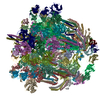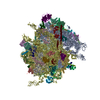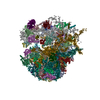[English] 日本語
 Yorodumi
Yorodumi- PDB-6v8i: Composite atomic model of the Staphylococcus aureus phage 80alpha... -
+ Open data
Open data
- Basic information
Basic information
| Entry | Database: PDB / ID: 6v8i | ||||||
|---|---|---|---|---|---|---|---|
| Title | Composite atomic model of the Staphylococcus aureus phage 80alpha baseplate | ||||||
 Components Components |
| ||||||
 Keywords Keywords | VIRAL PROTEIN / phage tail / tail tip / tape measure protein | ||||||
| Function / homology |  Function and homology information Function and homology information | ||||||
| Biological species |  Staphylococcus virus 80alpha Staphylococcus virus 80alpha | ||||||
| Method | ELECTRON MICROSCOPY / single particle reconstruction / cryo EM / Resolution: 3.7 Å | ||||||
 Authors Authors | Kizziah, J.L. / Dokland, T. | ||||||
| Funding support |  United States, 1items United States, 1items
| ||||||
 Citation Citation |  Journal: PLoS Pathog / Year: 2020 Journal: PLoS Pathog / Year: 2020Title: Structure of the host cell recognition and penetration machinery of a Staphylococcus aureus bacteriophage. Authors: James L Kizziah / Keith A Manning / Altaira D Dearborn / Terje Dokland /  Abstract: Staphylococcus aureus is a common cause of infections in humans. The emergence of virulent, antibiotic-resistant strains of S. aureus is a significant public health concern. Most virulence and ...Staphylococcus aureus is a common cause of infections in humans. The emergence of virulent, antibiotic-resistant strains of S. aureus is a significant public health concern. Most virulence and resistance factors in S. aureus are encoded by mobile genetic elements, and transduction by bacteriophages represents the main mechanism for horizontal gene transfer. The baseplate is a specialized structure at the tip of bacteriophage tails that plays key roles in host recognition, cell wall penetration, and DNA ejection. We have used high-resolution cryo-electron microscopy to determine the structure of the S. aureus bacteriophage 80α baseplate at 3.75 Å resolution, allowing atomic models to be built for most of the major tail and baseplate proteins, including two tail fibers, the receptor binding protein, and part of the tape measure protein. Our structure provides a structural basis for understanding host recognition, cell wall penetration and DNA ejection in viruses infecting Gram-positive bacteria. Comparison to other phages demonstrates the modular design of baseplate proteins, and the adaptations to the host that take place during the evolution of staphylococci and other pathogens. | ||||||
| History |
|
- Structure visualization
Structure visualization
| Movie |
 Movie viewer Movie viewer |
|---|---|
| Structure viewer | Molecule:  Molmil Molmil Jmol/JSmol Jmol/JSmol |
- Downloads & links
Downloads & links
- Download
Download
| PDBx/mmCIF format |  6v8i.cif.gz 6v8i.cif.gz | 3.7 MB | Display |  PDBx/mmCIF format PDBx/mmCIF format |
|---|---|---|---|---|
| PDB format |  pdb6v8i.ent.gz pdb6v8i.ent.gz | Display |  PDB format PDB format | |
| PDBx/mmJSON format |  6v8i.json.gz 6v8i.json.gz | Tree view |  PDBx/mmJSON format PDBx/mmJSON format | |
| Others |  Other downloads Other downloads |
-Validation report
| Summary document |  6v8i_validation.pdf.gz 6v8i_validation.pdf.gz | 1.7 MB | Display |  wwPDB validaton report wwPDB validaton report |
|---|---|---|---|---|
| Full document |  6v8i_full_validation.pdf.gz 6v8i_full_validation.pdf.gz | 1.9 MB | Display | |
| Data in XML |  6v8i_validation.xml.gz 6v8i_validation.xml.gz | 515.1 KB | Display | |
| Data in CIF |  6v8i_validation.cif.gz 6v8i_validation.cif.gz | 776.3 KB | Display | |
| Arichive directory |  https://data.pdbj.org/pub/pdb/validation_reports/v8/6v8i https://data.pdbj.org/pub/pdb/validation_reports/v8/6v8i ftp://data.pdbj.org/pub/pdb/validation_reports/v8/6v8i ftp://data.pdbj.org/pub/pdb/validation_reports/v8/6v8i | HTTPS FTP |
-Related structure data
| Related structure data |  20872MC  20873MC  20874MC  20875MC  20876MC M: map data used to model this data C: citing same article ( |
|---|---|
| Similar structure data |
- Links
Links
- Assembly
Assembly
| Deposited unit | 
|
|---|---|
| 1 |
|
- Components
Components
-Protein , 7 types, 72 molecules ACADCCCDBCBDAECEBECFBFAFBJBKBLDJDKDLAJAKALFJFKFLCJCKCLEJEKEL...
| #1: Protein | Mass: 37105.004 Da / Num. of mol.: 6 Source method: isolated from a genetically manipulated source Source: (gene. exp.)  Staphylococcus virus 80alpha / Strain: ST247 / Production host: Staphylococcus virus 80alpha / Strain: ST247 / Production host:  #2: Protein | Mass: 71114.680 Da / Num. of mol.: 3 Source method: isolated from a genetically manipulated source Source: (gene. exp.)  Staphylococcus virus 80alpha / Strain: ST247 / Production host: Staphylococcus virus 80alpha / Strain: ST247 / Production host:  #3: Protein | Mass: 125891.977 Da / Num. of mol.: 3 Source method: isolated from a genetically manipulated source Source: (gene. exp.)  Staphylococcus virus 80alpha / Strain: ST247 / Production host: Staphylococcus virus 80alpha / Strain: ST247 / Production host:  #4: Protein | Mass: 66872.477 Da / Num. of mol.: 18 Source method: isolated from a genetically manipulated source Source: (gene. exp.)  Staphylococcus virus 80alpha / Strain: ST247 / Production host: Staphylococcus virus 80alpha / Strain: ST247 / Production host:  #5: Protein | Mass: 43866.266 Da / Num. of mol.: 12 Source method: isolated from a genetically manipulated source Source: (gene. exp.)  Staphylococcus virus 80alpha / Strain: ST247 / Production host: Staphylococcus virus 80alpha / Strain: ST247 / Production host:  #6: Protein | Mass: 21551.746 Da / Num. of mol.: 12 Source method: isolated from a genetically manipulated source Source: (gene. exp.)  Staphylococcus virus 80alpha / Strain: ST247 / Production host: Staphylococcus virus 80alpha / Strain: ST247 / Production host:  #7: Protein | Mass: 73747.445 Da / Num. of mol.: 18 Source method: isolated from a genetically manipulated source Source: (gene. exp.)  Staphylococcus virus 80alpha / Strain: ST247 / Production host: Staphylococcus virus 80alpha / Strain: ST247 / Production host:  |
|---|
-Non-polymers , 1 types, 6 molecules 
| #8: Chemical | ChemComp-FE / |
|---|
-Details
| Has ligand of interest | N |
|---|
-Experimental details
-Experiment
| Experiment | Method: ELECTRON MICROSCOPY |
|---|---|
| EM experiment | Aggregation state: PARTICLE / 3D reconstruction method: single particle reconstruction |
- Sample preparation
Sample preparation
| Component | Name: Staphylococcus phage 80alpha baseplate / Type: COMPLEX Details: 80alpha baseplate attached to fully formed tails with no capsids Entity ID: #1-#7 / Source: RECOMBINANT | |||||||||||||||||||||||||
|---|---|---|---|---|---|---|---|---|---|---|---|---|---|---|---|---|---|---|---|---|---|---|---|---|---|---|
| Molecular weight | Value: 3.7 MDa / Experimental value: NO | |||||||||||||||||||||||||
| Source (natural) | Organism:  Staphylococcus virus 80alpha / Strain: ST247 Staphylococcus virus 80alpha / Strain: ST247 | |||||||||||||||||||||||||
| Source (recombinant) | Organism:  | |||||||||||||||||||||||||
| Buffer solution | pH: 8 | |||||||||||||||||||||||||
| Buffer component |
| |||||||||||||||||||||||||
| Specimen | Embedding applied: NO / Shadowing applied: NO / Staining applied: NO / Vitrification applied: YES Details: 80alpha tails (with baseplates) purified by centrifugation, polyethylene glycol precipitation, and CsCl density gradation | |||||||||||||||||||||||||
| Specimen support | Grid material: NICKEL / Grid type: Quantifoil R2/1 | |||||||||||||||||||||||||
| Vitrification | Instrument: FEI VITROBOT MARK IV / Cryogen name: ETHANE |
- Electron microscopy imaging
Electron microscopy imaging
| Experimental equipment |  Model: Titan Krios / Image courtesy: FEI Company |
|---|---|
| Microscopy | Model: FEI TITAN KRIOS |
| Electron gun | Electron source:  FIELD EMISSION GUN / Accelerating voltage: 300 kV / Illumination mode: FLOOD BEAM FIELD EMISSION GUN / Accelerating voltage: 300 kV / Illumination mode: FLOOD BEAM |
| Electron lens | Mode: BRIGHT FIELD / Nominal magnification: 29000 X / Nominal defocus max: 3700 nm / Nominal defocus min: 1700 nm |
| Specimen holder | Cryogen: NITROGEN Specimen holder model: GATAN 626 SINGLE TILT LIQUID NITROGEN CRYO TRANSFER HOLDER |
| Image recording | Average exposure time: 1.156 sec. / Electron dose: 104.33 e/Å2 / Film or detector model: DIRECT ELECTRON DE-20 (5k x 3k) / Num. of grids imaged: 10 / Num. of real images: 6483 |
| Image scans | Movie frames/image: 37 / Used frames/image: 1-37 |
- Processing
Processing
| EM software |
| |||||||||||||||||||||||||||||||||||||||||||||||||||||||
|---|---|---|---|---|---|---|---|---|---|---|---|---|---|---|---|---|---|---|---|---|---|---|---|---|---|---|---|---|---|---|---|---|---|---|---|---|---|---|---|---|---|---|---|---|---|---|---|---|---|---|---|---|---|---|---|---|
| CTF correction | Type: PHASE FLIPPING ONLY | |||||||||||||||||||||||||||||||||||||||||||||||||||||||
| Particle selection | Num. of particles selected: 515106 | |||||||||||||||||||||||||||||||||||||||||||||||||||||||
| Symmetry | Point symmetry: C6 (6 fold cyclic) | |||||||||||||||||||||||||||||||||||||||||||||||||||||||
| 3D reconstruction | Resolution: 3.7 Å / Resolution method: FSC 0.143 CUT-OFF / Num. of particles: 43601 / Symmetry type: POINT | |||||||||||||||||||||||||||||||||||||||||||||||||||||||
| Atomic model building | Protocol: RIGID BODY FIT / Space: RECIPROCAL / Target criteria: correlation coefficient Details: Initial models derived from I-TASSER predictions based on GenBank sequences of modeled proteins. Rigid body fitting in UCSF Chimera followed by manual extension in Coot. | |||||||||||||||||||||||||||||||||||||||||||||||||||||||
| Atomic model building | PDB-ID: 5EFV Accession code: 5EFV / Source name: PDB / Type: experimental model |
 Movie
Movie Controller
Controller







 PDBj
PDBj

